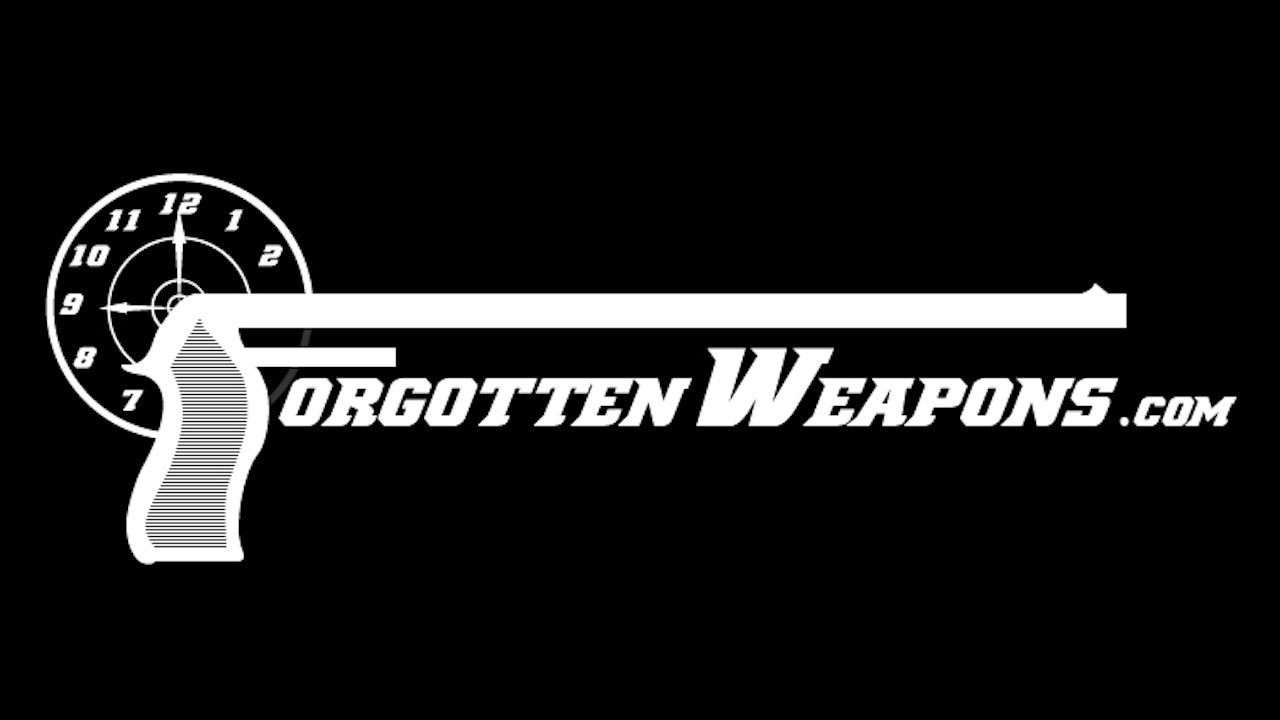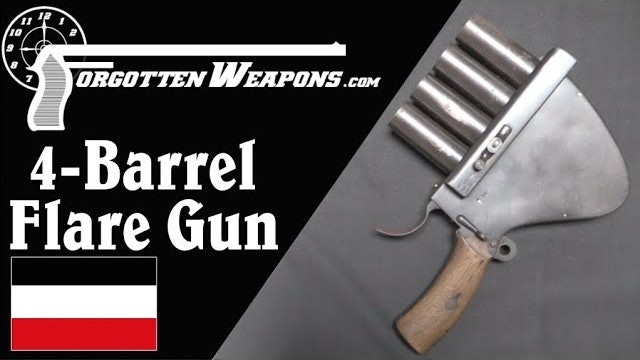-
Schmeisser's MP-18,I - The First True Submachine Gun
When Germany began looking in late 1915 for a new weapon ideally suited for the “last 200 meters” of a combat advance, Hugo Schmeisser’s blowback submachine gun would prove to be the weapon that would set the standard for virtually all submachine guns to come. It was a fully automatic only weapon...
-
MG-17 German Aircraft Machine Gun
The MG-17 is a belt-fed 8mm machine gun that was used on a large number of Luftwaffe aircraft early in World War II. The gun was developed by Rheinmetall through its subsidiary in Solothurn, Switzerland (as a way to evade the Versailles Treaty restrictions on arms development). The basic action i...
-
LAR Grizzly: A 1911 on .45 Winchester Magnum Steroids
Developed in the early 1980s by Perry Arnett, the LAR Grizzly was manufactured from 1983 until 1998. It was an expensive gun (base price was $675 in 1985), a huge gun (48oz / 1.36kg), and a powerful gun - its .45 Winchester Magnum cartridge throws a 230 grain bullet at 1450 feet/sec (15g @ 450 m/...
-
Lanchester MkI: Britain's First Emergency SMG
The Lanchester MkI was the first British effort to produce a domestic submachine gun during World War II. The British military had rejected these types of arms as "gangster guns" prior to the war, and did not see them as useful in a military context. Well, that opinion changed rather quickly as t...
-
Gebrüder Rempt Four-Barrel Enormous Flare Pistol
In 1917, the German military issued a contract for the construction of 2500 of these unique and impressive 4-barreled flare launchers. They were manufactured by 7 different companies (this example being from Gebrüder Rempt), and were intended for the illumination of airfields. To this end, they d...
-
Spanish MP41/44 - A Copy of the Erma EMP
The Spanish-made MP41/44 is a licensed copy of the Erma EMP submachine gun. The development begins with Heinrich Vollmer in 1925, designing a submachine gun for German military testing. The military trials showed a number of flaws in the gun, and Vollmer updated the design to fix them - but by th...
-
Chaffee Reece Model 1882: A Good Idea on Paper...
Patented in 1879 by Reuben Chaffee and General James Reece, the Chaffee-Reece rifle is an excellent example of how an idea that seems good on paper can easily become untenable in a fielded rifle. The main design premise of the rifle was to have a tubular magazine in the buttstock which held the c...
-
Professional Ordnance Carbon-15: A Super-Light AWB AR-15
The Professional Ordnance Carbon-15 was developed during the assault weapons ban in the United States as a way to market a pistol version of an AR15 action without exceeding the weight limit imposed by legislation. While Olympic Arms achieved this goal through extensive skeletonization, Professio...
-
Arsenal AF2011: A Double Barreled 1911 Monster Pistol
The Arsenal 2011 began as a manufacturing proof of concept, to showcase the technical ability of the company making it (their prior experience was largely in exquisite miniature firearms). It was introduced to the public at SHOT Show a few years ago, and garnered more purchases than had been anti...
-
The Yugoslav M56 Submachine Gun: Perhaps Too Simple?
The M-56 is a Yugoslav take on the MP-40 design, produced starting in 1956 to replace its previously issued M49 submachine gun (which was a copy of the Soviet PPSh-41). The M56 is simpler than the MP40, however, and chambered for the 7.62x25mm Tokarev cartridge. It is a simple gun to make, but qu...
-
A Unique Pre-WWI Custom Combination Gun
This unique custom sporting rifle (and shotgun) is a very cool example of the true gunsmith's art. This firearm began as a Mauser model 98 action, which was embellished and fitted with a fancy barrel (chambered for 8mm) and express sights. The gunsmith, Georg Knaak, of Berlin then added a shotgun...
-
The Brazilian Uru SMG: A Study in Simplicity
The Uru, named for a tropical bird, is a Brazilian 9mm submachine gun made from 1977 until 1985 and used by Brazilian military and police forces. What makes it interesting is the designer’s focus on simplicity - the gun has just 17 parts, and basically no screws or pins (except the bolt holding t...
-
The Star Z-63 Submachine Gun: Better Than You Think
The Star Z-63 is a 9x19mm version of the Star Z-62, which was made in both 9x19 and 9x23. Together, these represent the company’s effort to produce a more modern submachine gun than their Z-45, which was basically a copy of the German MP-40. The Z-63 is, contrary to its external appearance, a wel...
-
Shattuck "Unique" Hideout Squeeze Pistol
C.S. Shattuck’s “Unique” squeeze pistol is one of the last of this sort of sightless, underpowered hideout guns. Its core patent was actually filed by Oscar Mossberg, who worked for Shattuck before setting up his own company, which you are much more likely to have heard about today! Mossberg woul...
-
Remington-Rider Magazine Pistol
One of many firearms developed for Remington by Joseph Rider was the Rider Magazine Pistol - a manually operated 5-shot repeater chambered for the .32 extra-short rimfire cartridge (the same round used by the Chicago Palm Protector). It used a tube magazine under the barrel and a simple but cleve...
-
Four Fun Facts about the Oerlikon 20mm Antiaircraft Cannon!
Sold for $23,000 (transferrable).
The 20mm Oerlikon automatic cannon was a mainstay of United States naval air defense during World War 2, and today we will look at a few of the characteristics and questions that apply to this sort of automatic cannon but not to typical small arms. Like, for i...
-
The Mexican Luger
Mexico’s President for nearly 30 years, Porfirio Diaz was very interested in modernizing the Mexican Army. He invested in new artillery, magazine guns, and small arms - such as the Mondragon semiautomatic rifle. In addition, Mexico tested the Luger pistol circa 1903-1905. They found it to be quit...
-
The French MAS-38 Submachine Gun
The MAS-38 was France’s first officially adopted submachine gun, rushed into service in 1940. It was basically too late to help with the defense of France, with less than a thousand delivered by June 1940. The Germans kept the gun in production, making 20-30 thousand under the designation MP722(f...
-
Carl Gustav m/42: A 20mm Recoilless Antitank Rifle
The Swedish Pansarvärnsgevär fm/42 made by the Carl Gustav company was an interesting early hybrid antitank weapon - a recoilless rifle firing solid armor-piercing projectiles. It used a 20x180mm case, propelling the 108g (1650gr) bullet at 950 m/s (3150 fps). This was capable of perforating 40mm...
-
The Ljutic Space Gun
Al Ljutic (LEW-tic) was quite the interesting character, from his early days as a professional boxer to his selection for the US 1940 Olympic rifle team, to his eventual primary business making excellent high-end trap shotguns. One of the first was a gun he built for himself which wound up becomi...
-
Experimental Lightweight Browning High Power
One of the handguns that resulted from the post-WW2 interest in standardizing arms among the future members of NATO was a lightweight version of the Canadian produced Browning High Power. Experiments began in 1947 to create first a lightened slide by milling out unnecessary material, and then add...
-
Le Petit Protector Ring Pistol: A Modern Antique
Le Petit Protector is a ring pistol, made in both 5 shot/5mm and 6 shot/4mm pinfire variations, as well as a smaller version holding 7 rounds of 2mm pinfire, called the “Femme Fatale”. They are mechanically quite simple, with a manually cocked hammer, manually indexed cylinder, and can be reloade...
-
M3 and M3A1 Grease Gun SMGs
The US began looking for a cost-effective replacement for the Thompson submachine gun in 1942, and the “Grease Gun” was the result. Designed by George Hyde (a noted firearms designer at the time) and Frederick Sampson (GM/Inland chief engineer), it was a very simple and almost entirely stamped fi...
-
Gun Yoga Fail: The Fagnus Revolver
Produced by Alexandre Fagnus of Liege, this is a military style, six-shot, .450 caliber revolver with a particularly interesting and unusual unloading mechanism. The rear half of the trigger guard is a lever which can be rotated 90 degrees out from the frame, unlocking the barrel and cylinder. Th...

























